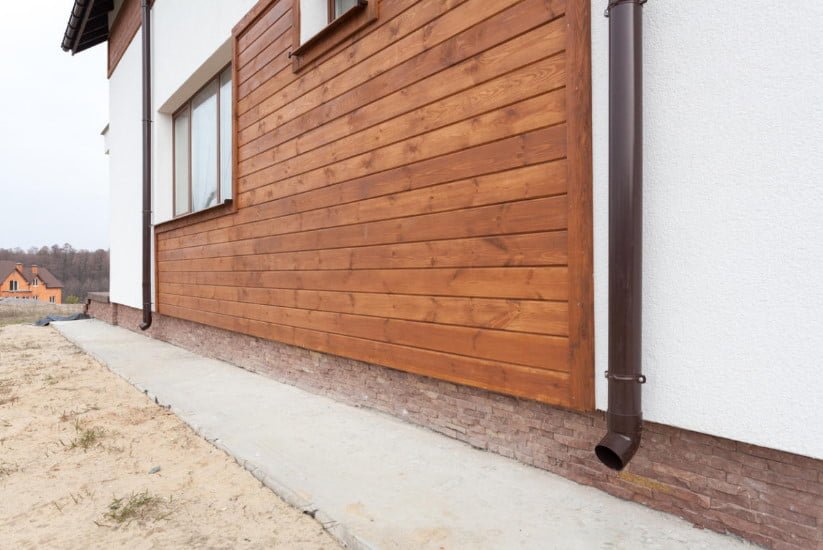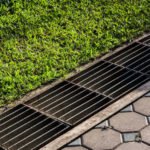No matter what the house is – small, large, frame, brick or log, it always consists of the same elements: foundation, walls, roof. And if no one objects to the importance of the foundation or roof for the strength and reliability of the structure, then many other structures may cast doubt on their necessity.
An example of such an element, not too necessary, in the opinion of a layman, is a blind area. If you have no doubts about the need for its construction, in this article you will find an explanation of the process of proper blind area.
Blind area device technology
As mentioned earlier, the blind area is used to protect any underground structures from the penetration of precipitation: snowmelt or rain. Therefore, it is made not only around the foundation of the building. With its help, water is removed from the well, fence, cellar.
The blind area consists of two parts: the underlying layer and the coating. The construction of the blind area can be prefabricated (from large-sized reinforced concrete products) or monolithic floors made of concrete, asphalt or asphalt concrete. Actually, it is this kind of zone that is commonly called the blind zone.
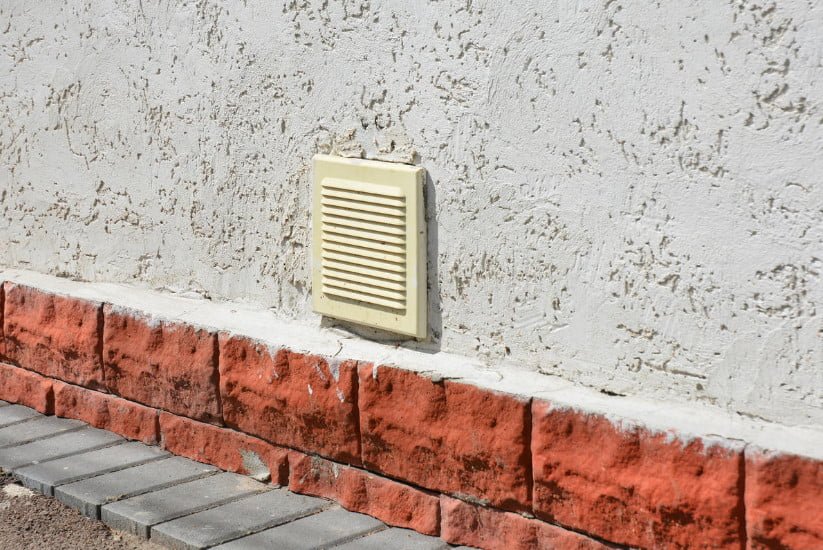
Although there is another type — soft blind area. Its coating is made of bulk materials of a large fraction (crushed stone, gravel, pebbles), turf or paving stones on a sandy base.
In a rigid blind area, the outer coating is the waterproof layer. In a soft layer of waterproofing, which protects the underlying layers, and the foundation is located below – under the turf or a coating of loose materials.
In general, the principles of hard and soft blind spots are similar, but there are differences, so we will consider both options. And let’s start from the beginning: construction of both types begins with earthworks.
Earthwork
However, digging a ditch can be avoided if you are just building a house. In the case of new construction, there is often already a pit, so the foundation is open, and additional excavation work is not required. In other cases, earthworks are carried out around the perimeter of the building.
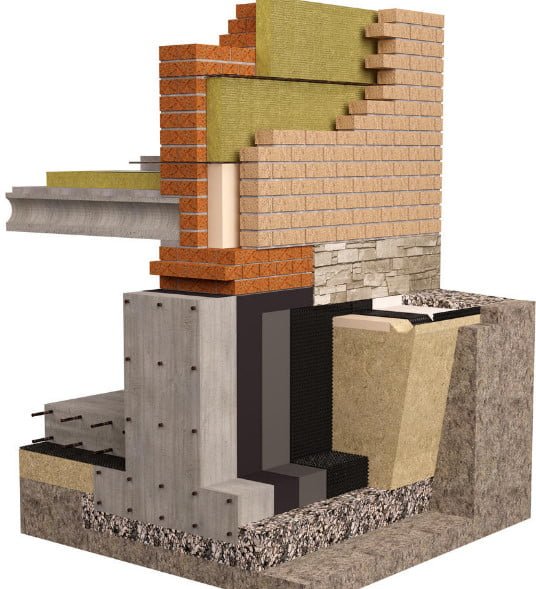
The width of the blind area is determined by the project. The minimum width for a private house is allowed 500-600 mm (19.6-23.6 in). the blind area strip should be wider than the roof overhangs by at least 150-200 mm (5.9-7.9 in).
If the blind area doubles as a walkway, then the optimal width is 1100-1200 mm (3.6-3.9 ft). A wide design is necessary in the case of construction on subsident soils (porous, with unstable physical and mechanical characteristics). In general, the wider you do it, the better: water drainage will be more efficient.
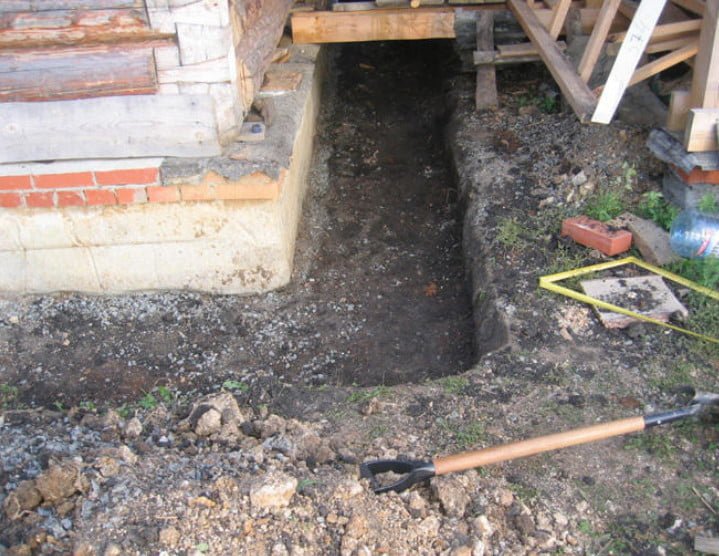
The trench should be made wider than the planned blind area for the convenience of installing the formwork and installing curbs if necessary. Remove the fertile soil layer to dense soil layers, for example, to a layer of clay, but not less than 300 mm (1 ft). the base of the trench is leveled and compacted.
If there is a pit, make waterproofing of the foundation and start backfilling.
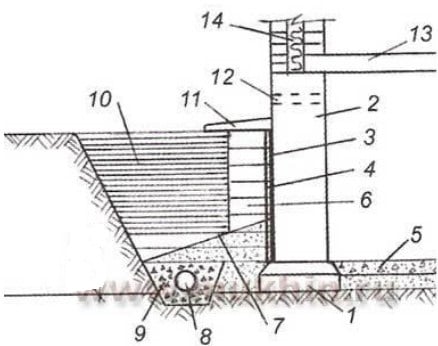
1 -Foundation; 2 -basement wall; 3 -waterproofing; 4-asbestos cement flat sheets; 5 – concrete basement floor; 6 – soil compaction zone by hand; 7 -boundary of drainage filling with sand; 8 -drainage pipe; 9 -filling of drainage with crushed stone; 10 -soil layers compacted by light mechanical ramming; 11 -blind area; 12 -ventilation box; 13 – basement floor; 14 -wall.
After filling the sinuses of the foundation with an intermediate tamper is made to a level 300-350 mm (1-1.1 ft) below the design mark, you can start creating a blind area. Further work depends on which version of the road surface is chosen – hard or soft.
The pavement without drainage — money down the drain
Before proceeding to the next stages of creating a blind area (the device of the underlying and covering layers), I want to focus on an important point – drainage. It should be borne in mind that the blind area is part of the drainage system.
This is not just a beautiful path around the house. The blind area is an important element of the water drainage system from the site, in particular, the drainage of the house. Therefore, simply making a concrete strip near the wall is not enough.
When installing a blind area, it is necessary to make a slope from the side of the building or structure to the outside. Building codes recommend a slope of 1 to 10%, depending on the width. That is, if the width of your blind area is 1000 mm (3.3 ft), then the difference in height relative to the horizontal plane at the wall and on the outside of the blind area will be from 10 to 100 mm (0.4-3.9 in).
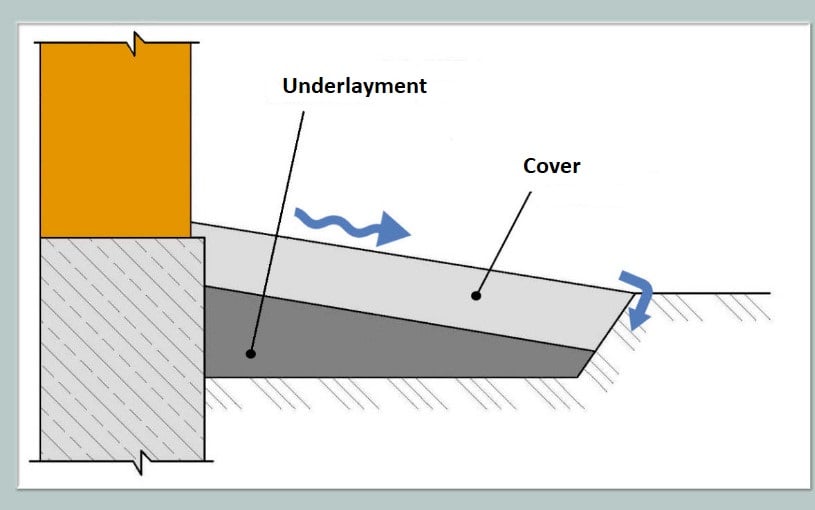
If the water flowing down the inclined plane of the blind area is not removed by drainage, the device of such a design will not only not improve the situation with wetting and destruction of the foundation, but will most likely aggravate it. Flowing water can flow under the blind area of the slab and seep into the foundation wall.
Of course, its amount will decrease, and the wider the blind area, the less moisture will get into the foundation. But the covering of the blind area will prevent evaporation, and the moist soil will freeze in winter and will be able to destroy the structure.
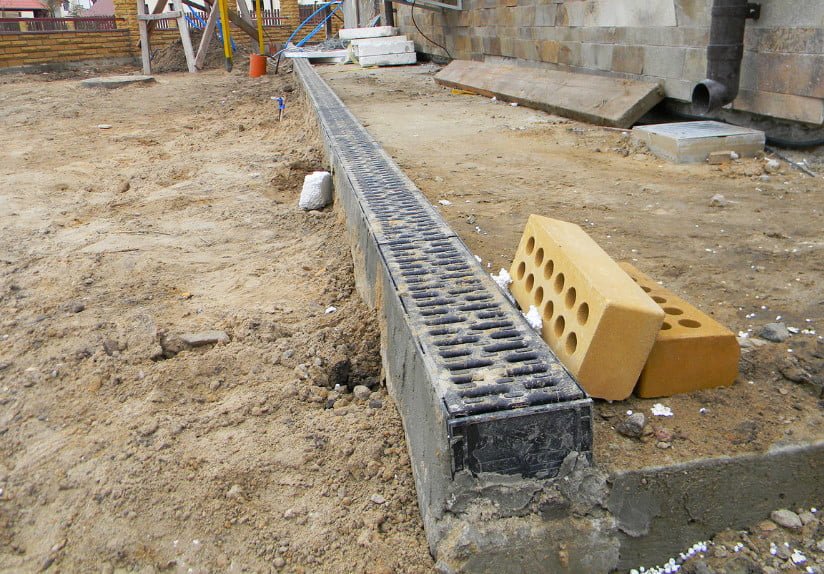
If the blindfold device is the last stage of filling the main sinuses, water will be absorbed by a deep wall drainage. If the blind area is arranged in a dug trench, then drainage trays should be installed along the edge. Although it is useful to do this in the case when there is a wall drainage.
At the preparatory stage of the blind area device, one should not forget about the water flowing out of the downpipes. If it is planned to install a storm sewer system, then water intakes must be installed before starting work on creating a road surface under the drains.
